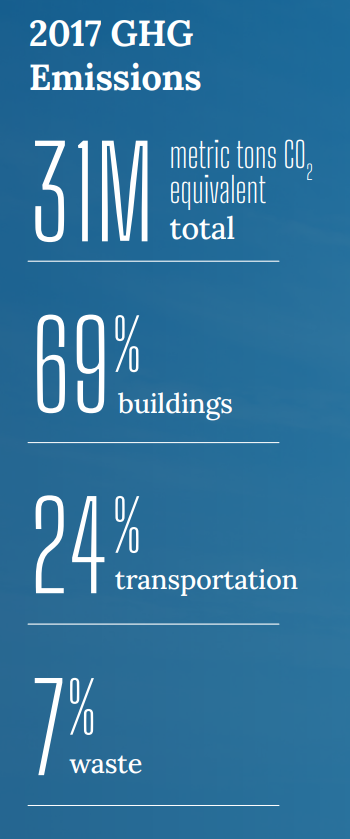Electrify Chicago
An independent tool for viewing City of Chicago building data
According to the
2022 Chicago Climate Action Plan,
69% of Chicago's emissions come from buildings, making
building emissions our biggest challenge and our biggest opportunity as a city
to tackle climate change. At Electrify Chicago, we showcase building performance using
publicly available data supplemented by community-submitted photographs and building
owners.
Start by looking at Chicago's buildings with the highest greenhouse gas intensity i.e. emissions per square foot. Large, efficient, buildings can perform much better than very inefficient small buildings on this metric.
New Article
📰 $30 Million In Missed Fines
The City Of Chicago failed to collect $30 million in potential fines from the building benchmarking ordinance, reducing transparency and accountability.
Legislative update! 🎉
As of late January 2024, legislation is being introduced to require new use more efficient forms of water and space heating, via the Clean And Affordable Buildings Ordinance (CABO), which will reduce the number of highly polluting and inefficient buildings that end up on this site.
If you're in Chicago,
write to your alderman to support the CABO!
Chicago Buildings by Greenhouse Gas Intensity
Note: Data includes large Chicago buildings with data from 2022, unless explicitly stated otherwise.
Note: This data only includes buildings whose emissions are reported
under the
Chicago Energy Benchmarking Ordinance. According to the City “As of 2016,
this list includes all commercial, institutional, and residential buildings larger than
50,000 square feet.” This dataset is also then filtered to only buildings with
reported emissions > 1,000 metric tons CO2 equivalent.
The latest year of data is from 2022, but we update the site regularly when new data is available, and some buildings may have failed to report that year, and only have older data available.
| Property Name / address | Primary Property Type |
Greenhouse Gas Intensity (kg CO2 eq./sqft) |
Total Greenhouse Emissions (metric tons CO2 eq.) |
|---|---|---|---|
|
Clark Place
2623 2627 N CLARK ST
| Multifamily Housing | 5.4 kg/sqft
Lowest 31%
| 803 tons
Lowest 46%
|
|
6640 50 W Belden Ave
6640 50 W Belden Ave
| Multifamily Housing | 5.4 kg/sqft
Lowest 31%
| 1,581 tons
Highest 30%
|
|
1224 W. Van Buren Lofts
1224 W Van Buren St
| Multifamily Housing | 5.4 kg/sqft
Lowest 31%
| 1,612 tons
Highest 29%
|
|
24 S MORGAN ST
24 S MORGAN ST
| Multifamily Housing | 5.4 kg/sqft
Lowest 31%
| 706 tons
Lowest 41%
|
|
Lakeside Lofts
🕰️
2025 S INDIANA AVE
| Multifamily Housing | 5.4 kg/sqft | 548 tons |
|
551 557 W NORTH AVE
(CHA)
551 557 W NORTH AVE
| Multifamily Housing | 5.4 kg/sqft
Lowest 31%
| 340 tons
Lowest 11%
|
|
4724 S VINCENNES AVE
4724 S VINCENNES AVE
| Multifamily Housing | 5.4 kg/sqft
Lowest 31%
| 463 tons
Lowest 23%
|
|
5042 5056 S WOODLAWN AVE
5042 5056 S WOODLAWN AVE
| Multifamily Housing | 5.4 kg/sqft
Lowest 31%
| 321 tons
Lowest 10%
|
|
Mark Twain Elementary -CPS
(CPS)
5131 S Linder Ave
| K-12 School | 5.4 kg/sqft
Lowest 31%
| 757 tons
Lowest 44%
|
|
3410 3412 N LAKE SHORE DR
3410 3412 N LAKE SHORE DR
| Multifamily Housing | 5.4 kg/sqft
Lowest 31%
| 1,034 tons
Highest 44%
|
|
The Carolan Apartments
5480 S CORNELL AVE
| Multifamily Housing | 5.4 kg/sqft
Lowest 31%
| 659 tons
Lowest 38%
|
|
2600 N HAMPDEN CT
2600 N HAMPDEN CT
| Multifamily Housing | 5.4 kg/sqft
Lowest 31%
| 350 tons
Lowest 12%
|
|
4600 N CUMBERLAND AVE
4600 N CUMBERLAND AVE
| Multifamily Housing | 5.4 kg/sqft
Lowest 31%
| 324 tons
Lowest 10%
|
|
10 South Riverside Plaza
10 S Riverside Plz
| Office | 5.4 kg/sqft
Lowest 31%
| 4,239 tons
Highest 8%
|
|
John Hancock
55 W Monroe
| Office | 5.4 kg/sqft
Lowest 31%
| 4,794 tons
Highest 7%
|
Data Source:
Chicago Energy Benchmarking Data
